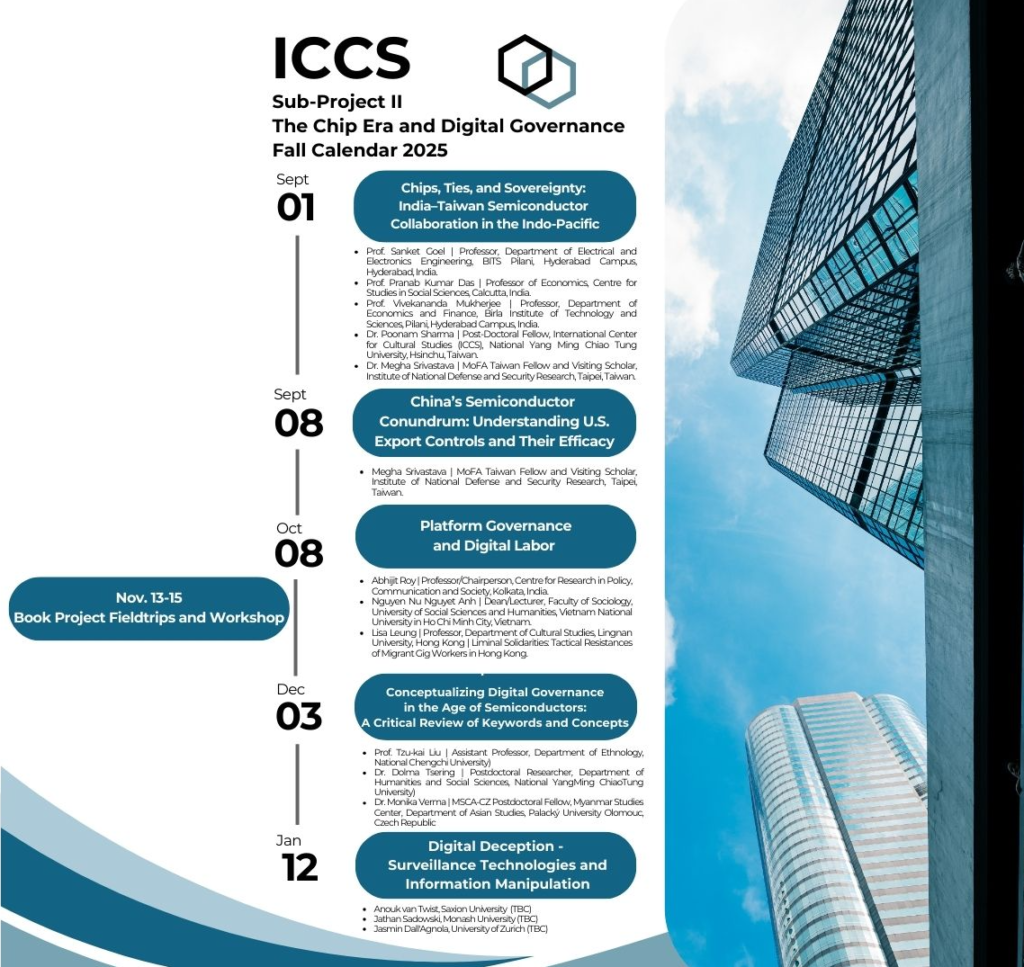Research Grants
Chip-Based Geopolitics & Economic Issues of Supply Chain
- Overview of India and Taiwan’s role in the global semiconductor industry.
- Economic and policy analysis of supply chain resilience.
- Impact of India’s semiconductor manufacturing projects in Gujarat and Assam.
The first fabrication facility is coming up in Dholera, Gujarat in partnership with Powerchip Semiconductor Manufacturing Corporation (PSMC), Taiwan with an investment of USD 109.71 billion. The fab’s capacity will be 50,000 wafer starts per month (wfsm), covering segments such as high-performance computer chips with 28 nm technology and power management chips for electric vehicles (EV), telecom, defense, automotive, consumer electronics, display, power electronics, etc. The project plans to take account of the position of India and Taiwan in the emerging global value chain in the global semiconductor industry. Another two, viz. CG Power in collaboration with Renesas Electronics Corporation of Japan and Mars Microelectronics of Thailand in Sanand, Gujarat with an investment of USD 91.63 million with a capacity of 15 million per day, and a semiconductor assembly, testing, marketing, and packaging (ATMP) facility by TATA group in Morigram, Assam with an investment of USD 325.99 million with a capacity of 48 million per day are coming up. As per govt. Estimates, these three new units will directly affect 20,000 high-tech positions and indirectly create an additional 60,000 jobs. A fourth one Micron – a US chip manufacturing company has committed to invest up to US$825 million to build a facility in India to assemble and test semiconductor chips.
In this process, India expects to gain from access to sophisticated technology. In the global market, it will join Taiwan, the USA, Japan, Thailand, Malaysia, Korea, and China in the production of chips. Indian entry is expected to stabilize the global supply chain by undermining China. It is also likely to be a source of capital and cheap skilled labor needed in this industry. India’s more vital role in geopolitics is expected to strengthen US policy to control China’s role in this war. Our study will focus on the issue of supply chain interdependence in the semiconductor industry. It will try to predict a strategy that will strike a ‘win-win’ situation for India and Taiwan in the emerging geo-political scenario through their cooperation in the Semiconductor industry.
Labor Migration and the “Chip” Friendship
- The impact of India-Taiwan economic ties on labor migration.
- Socioeconomic effects of increased labor mobility.
- Case studies on employment patterns in the semiconductor sector.
Taiwan’s “New Southbound Policy” and India’s “Act East Policy” have converged to bolster economic integration and trade growth between the two nations. In 2022, bilateral trade volume reached a record high, with significant investments from Taiwanese enterprises in various sectors under India’s “Make in India” initiative. Today, semiconductors have become an important geopolitical battleground, with the United States, Japan, and China investing heavily in domestic chip capacity. And India’s plan to establish itself as a semiconductor manufacturing hub includes attracting overseas chipmakers’ investments to catch up and save on high import costs while bolstering the local smartphone manufacturing industry. As India embarks on this journey, Taiwan emerges as a significant technological and strategic partner. A US$20 billion joint venture by Hon Hai Precision Industry and India’s Vedanta to build a semiconductor and display panel fab is underway, and more partnerships are on the horizon.
A small-scale pilot scheme will start first, and if that goes well, more Indian workers will be allowed in, the ministry said. It did not say, however, how many workers may eventually come — only that Taiwan would decide the numbers. The authorities also said the demand for workers in Taiwan in manufacturing, construction, and other industries has continued to expand. At the same time, the exchange would also enefit India, by opening employment opportunities for the workers seeking a job in the labor industry and migrating abroad. Although India has no formal ties with Taiwan, this agreement on migration has enabled both nations to have a socio-economic impact through the dimensions of exchanges and interactions through these labor exchanges.
Significantly, India has a difficult geopolitical relationship with China, especially over their disputed shared borders. By all public accounts, there is no indication of how the India-Taiwan migration would be done differently from existing migration arrangements with Indonesia, the Philippines, Thailand, and Vietnam. But this migration would also enable us to study the varying degrees of experiences between White and blue-collar working migrants from India residing in Taiwan. It should be noted that Taiwan already hosts a large group of Indian ex-pats working in the Semiconductor industry. At the same time, the number of migrants from Taiwan to India is considerably low. Will India also emerge as a destination to host labor migrants from Taiwan as a part of its semiconductor growth and development? Additionally, the research project aims to delve deeply into understanding Taiwan’s strategic significance within the broader context of regional stability and the evolving geopolitical dynamics, especially concerning China’s DSR initiative. This objective involves a comprehensive investigation into Taiwan’s role in enhancing regional stability, fostering digital infrastructure development, and contributing to chip cooperation in the Asia-Pacific region. By examining Taiwan’s strategic position vis-àvis the DSR, the study aims to uncover potential areas of collaboration, strategic partnerships, and diplomatic engagements between India and Taiwan to address the challenges posed by China’s digital ambitions and promote regional stability and security.
Cybersecurity & Digital Infrastructure
- China’s influence through the Digital Silk Road and its impact on India.
- Cybersecurity threats and data sovereignty concerns.
- India’s digital resilience and Taiwan’s role in countering threats.
This project also aims to conduct an in-depth analysis of China’s Digital Silk Road initiative and its extensive ramifications for India’s technological reliance, security challenges, migration patterns, and Taiwan’s strategic significance in the Asia-Pacific region. The project brings together expertise in cybersecurity, digital infrastructure, migration studies, and socio-economic analysis to provide a comprehensive understanding of the multifaceted dynamics involved. This research project also aims to explore Taiwan’s strategic role in the context of regional stability and evolving geopolitical dynamics, particularly concerning China’s Digital Silk Road initiative. The objective involves a comprehensive investigation into Taiwan’s contributions to enhancing regional stability, fostering digital infrastructure development, and promoting chip cooperation in the Asia-Pacific region. By analyzing Taiwan’s strategic position vis-a-vis the Digital Silk Road, the study intends to identify potential areas of collaboration, strategic partnerships, and diplomatic engagements between India and Taiwan to tackle the challenges posed by China’s digital ambitions and promote regional stability and security. This joint research initiative represents a concerted effort to delve deeply into the complex interplay of technological, economic, and geopolitical factors shaping Indo-Taiwan collaboration, migration dynamics, and regional stability in the wake of China’s Digital Silk Road initiative.
Theoretical Speculation on a New “Nomos of the Earth”
- Philosophical and geopolitical implications of digital connectivity.
- How digitization reshapes global order and governance.
Lastly, the project will delve into Chip-Based Geopolitics, providing an indepth analysis of how semiconductor supply chains, innovation ecosystems, and geopolitical tensions intersect. By examining these dynamics, the research aims to elucidate how chip-based geopolitics influence regional economic dynamics, strategic partnerships, and the broader landscape of global technology competition. We are compelled to consider digitization and digital space as forces driving global transformation of the social fabric. This perspective aligns with Menne’s (2023) critical view, where digital advancements intersect with historical sociocultural dynamics, reshaping power structures and challenging traditional notions of sovereignty and order in the digital realm. Through this lens, the DSRI not only represents a technological leap forward but also acts as a catalyst in the creation of what in Schmittian terms may be called a “digital nomos.”






